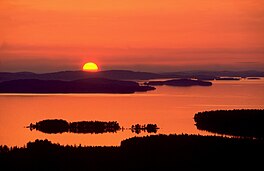| Pielinen | |
|---|---|
 Pielinen as seen from Räsävaara. | |
| Location | North Karelia |
| Coordinates | 63°15′N 29°40′E / 63.250°N 29.667°E |
| Lake type | Mesotrophic |
| Primary inflows | Jongunjoki, Koitajoki, Lieksanjoki |
| Primary outflows | Pielisjoki |
| Catchment area | 12,823 km2 (4,951 sq mi) |
| Basin countries | Finland |
| Max. length | 120 km (75 mi) |
| Max. width | 40 km (25 mi) |
| Surface area | 894.21 km2 (345.26 sq mi)[1] |
| Average depth | 9.9 m (32 ft) |
| Max. depth | 60 m (200 ft) |
| Water volume | 8.5 km3 (2.0 cu mi) |
| Residence time | 1.9 years |
| Shore length1 | 1,700 km (1,100 mi) |
| Surface elevation | 93.7 m (307 ft)[1] |
| Islands | Paalasmaa (27.2 km2), Kynsisaari (13.7 km2), Porosaari (10.4 km2), Toinensaari (8.2 km2), Hattusaari (6.3 km2), Koveronsaari (6.1 km2) and Retusaari (5.6 km2) |
| Settlements | Juuka, Lieksa, Nurmes |
| References | [1] |
| 1 Shore length is not a well-defined measure. | |
Pielinen (Swedish: Pielisjärvi)[2] is the fourth largest lake of Finland, with a drainage basin area of 12,823 km2 (4,951 sq mi) equally distributed between eastern Finland and Russia. The creation of the lake and its outlet is attributed to a post-glacial isostatic rebound, which resulted in uplift of the land.[3][4][5] As is common in Finnish lakes, the lake's color is dark, due to the high proportion of bogs present in the catchment of the drainage basin that drains humic substances.[3][4]
Pielinen Lake is in the northernmost part of Finnish Karelia in the region of North Karelia. It is adjacent to Koli National Park, known for its scenery in summer, and winter skiing; and is near the whitewater rafting centres at Ruunaa Hiking Center, Lieksa and Nurmes.[6]
- ^ a b c "Pielinen at Jarviwiki". Finnish Environment Institute. Retrieved 2020-04-15.
- ^ "Svenska ortnamn i Finland - Institutet för de inhemska språken".
- ^ a b "Lake Pielinen". International Lake Environment Committee. Archived from the original on 2011-05-23. Retrieved 2010-11-05.
- ^ a b "Lake Pielinen". Encyclopædia Britannica. Retrieved November 24, 2010.
- ^ Heikki Seppä; Matti Tikkanen & Jari-Pekka Mäkiaho (2012). "Tilting of Lake Pielinen, eastern Finland – an example of extreme transgressions and regressions caused by differential post-glacial isostatic uplift". Estonian Journal of Earth Sciences. 61 (3): 149–161. doi:10.3176/earth.2012.3.02.
- ^ "Introducing Lake Pielinen Region". Lonelyplanet. Retrieved November 24, 2010.
